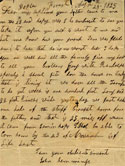 John Hemmings (1776–1833) was the son of the slave Elizabeth Hemings and, family tradition holds, Joseph Neilson, a white Monticello workman. Thomas Jefferson's wife Martha Wayles Skelton Jefferson inherited the Hemings family of slaves from her father John Wayles, and members of this extended lineage held many positions of trust at Monticello. John Hemmings was a literate and highly skilled house joiner and craftsman with talents that extended from the fabrication and repair of complex pieces of farm equipment, through the creation of elegant furniture, to finishing work at Monticello and Poplar Forest, Jefferson's Bedford County retreat. In 1826 Hemmings constructed Jefferson's coffin and was one of only five slaves freed in his will. Known as "Daddy," Hemmings and his wife Priscilla, a nursemaid at Monticello often referred to as "Aunt," were close to all of Jefferson's grandchildren, and particularly so to the two youngest, Septimia and George.
John Hemmings (1776–1833) was the son of the slave Elizabeth Hemings and, family tradition holds, Joseph Neilson, a white Monticello workman. Thomas Jefferson's wife Martha Wayles Skelton Jefferson inherited the Hemings family of slaves from her father John Wayles, and members of this extended lineage held many positions of trust at Monticello. John Hemmings was a literate and highly skilled house joiner and craftsman with talents that extended from the fabrication and repair of complex pieces of farm equipment, through the creation of elegant furniture, to finishing work at Monticello and Poplar Forest, Jefferson's Bedford County retreat. In 1826 Hemmings constructed Jefferson's coffin and was one of only five slaves freed in his will. Known as "Daddy," Hemmings and his wife Priscilla, a nursemaid at Monticello often referred to as "Aunt," were close to all of Jefferson's grandchildren, and particularly so to the two youngest, Septimia and George.
Septimia Anne Randolph (1814–1887) and her younger brother George Wythe Randolph (1818–1867) were the last children born to Thomas Mann Randolph and Jefferson's eldest daughter Martha. Jefferson's grandchildren often visited "Daddy" Hemmings while he worked in the Mulberry Row joinery, but an especially strong bond existed between John Hemmings and Septimia. After Hemmings traveled to Poplar Forest late in 1815, he confided to Septimia's much older sister Ellen a year later that "he had cried for about five miles of the road after taking leave of her." Septimia married David Scott Meikleham at Edgehill, the home of her brother Thomas Jefferson Randolph, in 1838. She was Jefferson's last surviving Randolph grandchild.
Hemmings was heavily engaged in completing work at Poplar Forest from 1819 through most of 1825, and during his lengthy stays there he wrote regularly to Jefferson to report progress, discuss construction problems, and request materials. Twelve of these letters survive and will be included in future volumes of the Retirement Series. The letter from eleven-year-old Septimia that prompted Hemmings's reply given below has not been found, and Hemmings's letter is the only extant piece of correspondence between them.
your Letter came to me on the 23th and hapey was I to embreasit to see you take it upon you self to writ to me and Let me know how your grand Pare was Glad am i to hear that he is no worst dear I hope you ar well and all the famely giv my Love to all your brothars Gorg with Randolph speculy i shoul gite don the house on Tusday that is tining it we1 have all the Tarrst2 to do yet wich is one hundred feet Long and 22 feet 8 inchs wide yesterday we just hade one Lode of the stuff brought home fore the gutters and that is 25. mils off whare it came from I am in hops I Shol be able to Com home by the 25 of November Ef Life Last
I am your obediante sirvant
RC (ViU: Randolph-Meikleham Family Papers); addressed: “To miss Septima monticello,” to be delivered by “John.”
1Hemmings may have meant his enslaved nephews Madison Hemings (b. 1805) and Eston Hemings (b. 1808), sons of Sally Hemings and Thomas Jefferson, who often served as assistants to their uncle.
2Thus in manuscript, possibly meaning “terrace.”
COPYRIGHT NOTICE: Published by the Thomas Jefferson Foundation and copyrighted, ©, by the Thomas Jefferson Foundation. All rights reserved. No part of this publication may be reproduced in any form by any electronic or mechanical means (including photocopying, recording, or information storage and retrieval) without permission in writing from the publisher, except for reading and browsing via the World Wide Web. Users are not permitted to mount this file on any network servers.